“Finding yourself assailed by enemies, and supposing there are many of them, the situation demands nothing less than attacks like those of a desperate man, that is to say you must enter liberally into the fray”
Giuseppe Colombani (1711)
The scarcity of advice for multiple opponent combat, within the rich literature of several hundred European fightbooks, has often been noted.1
Moreover period masters are often quick to admit that fighting more than one assailant can be particularly difficult and dangerous. The German master Michael Hundt in 1611,2 suggests carrying a bag of stones to throw at your opponents, or to throw your sword at them before fleeing. This might appear to border on the comical, but of course running from a perilous situation is eminently sensible, and reminiscent of the longsword advice attributed to Döbringer, not to stand and fight when faced with four or six peasants.3
The Rapier in Group Combat?
The rapier: a long slender sword, arguably optimised for unarmoured civilian duelling, is seen as particularly alien to the chaos of multiple foes. George Silver famously characterises the rapier as a bird-spit, suited only to murder in peacetime duels, with rapier masters teaching only the thrust, never the cut.4
As a comment on the wider technical literature, these suggestions are demonstrably false.
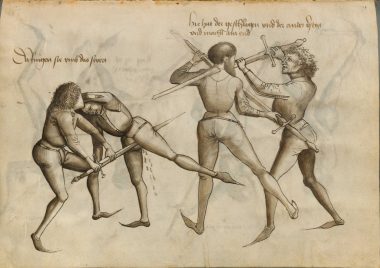
Italian rapier treatises follow the general rule that technical advice is heavily weighted towards single combat. However scattered references for fighting multiple opponents arise in several treatises. This advice is broadly consistent in the works of various masters over the course of more than a century. Furthermore analogous advice is given in less obviously related systems from different time periods, for different weapons, and from outside the Italian peninsula.5
The striking feature of this advice, is its direct, forceful simplicity; often predicated upon powerful, sweeping cuts. In contrast to the more intricate, thrust-centric play assumed within the salle, or in a duel against a single, skilled opponent.
The contrast is perhaps most stark between the two treatises of Nicoletto Giganti. His first describes the fundamentals of swordsmanship, and advocates a thrust-centric approach, implicitly for use in the salle or in single combat against a competent fencer.
This changes in his second treatise, which among other situations addresses self-defence with the dagger, combat against untutored opponents; and indeed the aforementioned big, sweeping cuts for dealing with multiple attackers.

Even Costantino Calarone, a late-period rapier master genuinely hostile to cuts, concedes they are indispensable against multiple opponents. Although his advice against several adversaries focuses on measure and positioning (again recalling Döbringer), ultimately he presents his chapter on cuts as a necessary segue from his section on multiple opponents.
Commonalities with the spadone
It is also noteworthy that self-defence against several attackers is one area where techniques for the rapier and for the two-handed spadone overlap. Certain actions find analogies in works for the Iberian two-handed montante,6 as well as in Francesco Ferdinando Alfieri’s spadone treatise of 1653.7 While explicit parallels are drawn between the two weapons both in the brief discourse of Giuseppe Colombani in 1711, and in the lengthier discussion of Giuseppe D’Alessandro in 1723 (published posthumously, following his death in 1715).
Indeed these two writers are distinguished as among the last to provide technical advice for the spadone. Furthermore D’Alessandro presents a single spadone plate in addition to the text.
D’Alessandro’s treatise is notable for containing the most extensive discussion of multiple combat in the Italian rapier corpus.
This vast work primarily concerns equitation, but contains ample digressions into fencing, not least on several specific tactics to employ against several adversaries: a method very similar to Giganti’s, alongside techniques he names respectively as the ventaglio (fan), and the sbaratto tondo (round fury).
Since this has never before been translated into English, D’Alessandro’s advice for dealing with multiple opponents is presented below, alongside the shorter notes of selected earlier authors. The earliest of these (that of Lovino) is generally considered a sidesword text by our modern HEMA taxonomies, but is included as an additional data point.
A Portrait of a Master
It is gratifying to imagine, three hundred years after his death, that a master with no written testimony of his own, might have left some small legacy. So before proceeding with the technical detail (such as it is, given the directness and ferocity of the advice), it seemed apt to present D’Alessandro’s affectionate personal portrait of Sir Captain Giacomo Alvino, the master who taught him the aforementioned ventaglio:

He fenced with the sword with incomprehensible agility. He was an attacking fencer, intrepid, always coordinated, when in measure trusting in the speed of his hand and not hesitating to deliver a straight lunge, being a capable exponent of this principal aspect of fencing.
He did not lose in the bind, or with disengagements, or in tempo, and was just as accomplished with the sword and dagger, with the sword alone, and with the smallsword against sword and dagger.
He employed a particular play called the ventaglio, and since I was his student, I had the fortune to witness the marvels of this great man. At the time I was taking lessons, from all this I became very nimble in the assault, while the said Sir Captain was around seventy years old.
I saw him one time perform the said ventaglio against three strong assailants. Not only could they not hit him, but they were left completely overwhelmed, such that they were forced to quit the assault.
I had begged him many times to practice just one assault with me, and for the most part he replied that he was old, and out of practice for rigorous assaults. But one day when I and other gentlemen begged him, he conceded to assault with us. I have neither the pen, nor the tongue to describe the smallest part of the prodigies we admired from this gallant man that day; all the more so because he was so old, and corpulent.
The same ease and directness that he used with a practice sword, he also applied with a sharp sword, since he was very brave, and sensitive.
The foremost gentlemen of this realm who loved fencing, held him in great esteem, and sought to become his students. He died at around seventy-five years of age, to general grief, all the more because he was in good humour, lively, kind, and good-hearted, no matter how grim and stern his countenance appeared.”8
Advice for Confronting Multiple Opponents: Translations From Selected Italian Treatises
Giovanni Antonio Lovino (c.1580)9
Leonida is attacked by his enemies, Cassandro and Eraclio, with sharp swords and cloaks wrapped round their arms.
Cassandro, one of the attackers, quickly approaches Leonida from one side, well settled in guardia di dentro,10 and begins to press him with thrusts. One the other side Eraclio, Cassandro’s friend, sets himself against Leonida, with his cloak advanced, and his sword high as if wishing to attack.
Leonida, finding himself enclosed between his two foes, however does not lose heart. He covers himself completely under his sword, turning its point against Cassandro, and its edge against Eraclio’s threat.
From here, he attempts to displace Cassandro’s point with his cloak, always employing the cloak to keep his enemy’s sword in check. Meanwhile he delivers some good cuts towards Eraclio.
Nonetheless, while continually watching Cassandro’s sword, he feints entering with a thrust, to dissuade Cassandro from overwhelming him, these feints being performed quickly after he has cut at Eraclio. After this, on occasion he feints an intention to thrust, only to cut at Eraclio’s body.
Meanwhile Eraclio and Cassandro, one with cuts the other with thrusts, attack Leonida with resolve.
Leonida keeps himself safe with his hands and his feet, defending with his cloak, parrying and evading with his body as the situation demands. He always attempts to attack the right side of the opponent who troubles him the most.
In this manner he copes admirably, with his sound judgement; defending himself honourably with heart, and knowledge, against his enemies Cassandro and Eraclio.
Salvator Fabris (1606)11
If for example two fencers confront each other, one being skilled with the cut, the other with the thrust, without a doubt the latter will beat the former, for the reasons stated above, even if the former was the more powerful. Therefore, in conclusion, it is better to stick to the thrust, especially in unarmoured single combat. In armoured combat it is better to employ both cut and thrust, and likewise against multiple opponents, since the cut creates greater confusion, and can parry multiple blows with a single attack.
Nicoletto Giganti (1608)12
I would like to teach you how to defend yourself with cuts, in cases of necessity, against two or three people. If you are attacked by two people, as often occurs, if you cut a mandritto at one, in that tempo the other will strike at you. While if you thrust at one, in that tempo you will take a thrust from the other. Therefore you will quickly find yourself dead, as has happened to many.
In order to both attack and defend, I want you to keep your sword high as if to deliver a mandritto. If both thrust at you simultaneously, you should cut a mandritto into their swords, followed by a roverscio.
The mandritto should be delivered so it almost wounds your enemy’s neck, and finishes ready to attack again from the left. In this manner the mandritto has two effects, it offends and protects at the same time. Having delivered the mandritto you should bring your body and foot back, put the sword under your left arm ready for the roverscio, then quickly execute this roverscio as follows. It should begin by attacking your opponent’s neck, and end once more on your right side.
The mandritto and roverscio therefore attack in the form of a cross. With this method you both attack and defend, since your sword must inevitably find your enemies’ weapons. Note that these mandritti and roversci should be delivered long, hard, quickly, and without ever stopping. As soon as you perform the mandritto the roverscio should follow. Likewise having delivered the roverscio, you should execute the mandritto without any delay. In other words they should continue like a wheel.
To perform these sorts of cut, you must exercise by delivering mandritti and roversci to condition your arm and quicken your legs, training by executing two or three hundred cuts, and just as many roversci, without stopping. In this manner anyone can parry thrusts, even from three or four opponents, while wounding and keeping the enemy at bay to the full length of their sword, by delivering long, quick, strong and wide cuts.
These sorts of cuts are such, that if an unarmoured gentleman with the sword alone is attacked by a fully armoured enemy with sword and dagger, who sets upon him with thrusts and imbroccate, he can defend his life as follows.
He should hold his sword as described above, high as if to cut, and as his enemy thrusts he should send a mandritto into his sword, followed by a swift roverscio to his head, or else to his legs, before quickly returning out of measure.
This is because by delivering a mandritto into the enemy’s sword as he thrusts, he will cast his enemy’s sword to the ground, and by returning his own sword forward he is able to perform not just one roverscio, but two or three, before quickly retreating back.
If the enemy delivered a hundred consecutive thrusts, he could parry all of them safely, and wound his enemy with a roverscio to the face or legs.
Furthermore cuts delivered in this manner are such that, if your opponent delivered an imbroccata or thrust, by parrying it with a mandritto, you might easily cause it to fall from his hand, finding his arm weak after having thrust. I therefore urge anyone who desires to practise, to deliver cuts in this manner, so they defend and attack, unlike other cuts which only offend but do not protect if the enemy strikes in the same tempo.
Giuseppe Colombani (1711)13
The rule for the two-handed spadone against multiple swords.
This applies both to a two-handed spadone and to a long sword. Finding yourself assailed by enemies, and supposing there are many of them, the situation demands nothing less than attacks like those of a desperate man, that is to say you must enter liberally into the fray. You should never deliver thrusts with the point, except at an opponent who seems weaker, instead delivering roversi, such attacks keeping you always in motion, this being the true method of defending yourself.
Costantino Calarone (1714)14
Against Multiple armed opponents.
Day six. Chapter XVIII.
Master and Disciple
Ma: Future generations will judge me as overbearingly bold, for wishing to describe the method by which one person with the sword alone, should comport themselves against multiple armed opponents, since your request is squarely contradicted by the saying Nec Hercules contra duos.15 I could never believe that a man born to civility, might affront another, often being reminded by his elders that a fellow’s good name is his honour. Nor can we say, that the prudent must make concessions to circumstance, since someone adopting this position will still be deemed overbearing.
But to answer your question, I will endeavour to respond to your request. Your actions should always be moderated by such a prudent manner, that no-one will ever have cause to commit you an affront. Nevertheless, for those incidences that may arise, I undertake to explain the method of defending yourself in these situations.
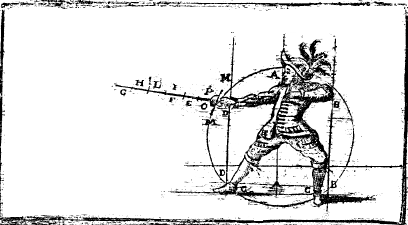
Calarone’s pianta perfetta
Finding yourself therefore in such a predicament, with just the sword alone in hand, you should not put yourself in pianta perfetta,16 but in passo misto,17 so your body’s movements are more agile. You should not deliver thrusts, unless you are in the measure of just a single opponent. You should not stay planted. Nor should you withdraw your body with backwards steps. Instead you should wheel to the right. Your parries should not be light touches but circular, with your wrist, and your sword. In this manner, without doubt you will emerge victorious.
Di: Your instructions have always been very useful to me, and I hope these are no less useful than previous ones. Therefore I pray you are happy to indulge me, by elaborating upon these six precepts you have outlined, so that if needed I can put them into practice.
Ma: As I said I cannot imagine that an honourable man might commit an affront, even by accident. Since civility will have him consider, that someone who has stained their honour will always be viewed with suspicion. Nonetheless I wish to satisfy your demand, while advising you to stay clear of that sort of person, because if someone accepts the malice of others, they can easily become infected themselves. Nor should we say “it was an accident, now he has changed”, because a wolf that acts as a lamb should not be trusted. And one who trusts him is a fool.
Now, returning to our discussion, I say therefore that you should not put yourself into pianta perfetta, but into mista, for two reasons. The first is to find yourself more agile in passo misto, more ready in defence, and effortless in circling from one spot to another.
The second is to keep out of your adversaries’ measure, while one opponent is within your perfect measure,18 such that whether you attack him with a cut or a thrust, you are able to save yourself. When in a narrow stance, by just advancing one foot (your right), you can attack with a thrust and quickly return to your defence. Likewise if you wish to attack with a cut (although it is dangerous) by extending your foot a little further you can execute the cut.
You should not deliver either a thrust or a cut, unless you are in the measure of just one opponent, for two reasons, as you can see from the figure at A:1.
The first, is that if you attack within the measure of many opponents, you could easily be hit. Because while you try attack one adversary, you cannot deal with the thrusts of the others.
The second reason, is that by attacking within the measure of just one opponent, you can consider (before the attack), how to save yourself afterwards, and likewise the most opportune way to strike.
You should not stay firm in one place, because your opponents could easily surround you, and attack you from both the front and the back. Instead you should walk in a circle, as shown by the figure A:7.
You must withdraw your body, but not by stepping back, because going backwards mishaps are more likely, like bumping into a stone and falling to the ground on your back, stumbling with your left and falling on your flank, or bumping your back into some wall, and being forced to commit your body in a tempo not of your choice.
From this, you can clearly discern that in manoeuvring your body, you should move it by circling, and always to the right, as the figure shows. In this manner, you evade the measure of the opponents marked 2, 3, 4, 5, & 6, dealing with only one. In addition you cannot be surrounded, you will not stumble with your left or right foot, and will not come up against a wall, whereupon you could no longer defend yourself.
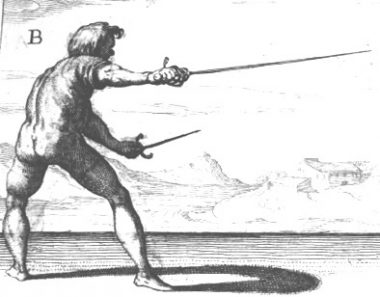
But to understand my reasoning better, put it into practice. You will find it perfectly valid from evidence, proof and experimentation. Do not view combat against many strange the first few times, because ex frequentatis actibus fit habitus.19
However since you cannot defend yourself against many, without employing the cuts I so abhor, on another day I will demonstrate how these are performed. For now I will retire, not for lack of devotion in instructing you, but because the hour is late.
Giuseppe D’Alessandro (1723)20
Now we turn to play against more than one opponent, which is always an unhappy predicament, since as the proverb states not even Hercules could manage against more than one.
Nonetheless experience shows that the valorous can overcome any danger, as confirmed by [Torquato] Tasso who states that:
“All roads are level for the spirited”
and likewise elsewhere that:
“When peril is greatest, the best advice is audacious”
I will begin with the assault against two people. You should disorder21 the enemies’ swords with a series of cuts, either to the inside or the outside, then cease these cuts and wound to the nearest opening.
In addition you can also motion some thrusts towards them, particularly to the face of the one to the left of his companion. If in this feverish and vital moment he cedes with his body, or with a step backwards, with just a turn of the wrist from the position in which you find your arm, you can bring down a cut onto the edge of his weapon.
With a free and unburdened spirit, with this method and in the manner that follows, it is expedient to take any good opportunity presented amid the confusion; either from the enemies’ fear, from overconfident frustration, or if one of them drops their sword, which can easily happen when the cut onto their weapon arrives in tempo, onto their weak.
If you find yourself in these circumstances with a dagger in your left hand, in this case, with great care, you should try to use the dagger to parry the enemies’ blows. In this sort of confrontation I do not recommend throwing back your left arm while lunging forward, either with a cut or thrust. Instead your left arm should stay forward, in a posture and position where it can defend you from the enemies’ attacks in any tempo.
They will seek to gain the line either outside your right flank, or to the inside towards your left, which presents greater difficulty to the single defender. Therefore you should always direct your opponents to the line to the outside of your right arm, where you can guard yourself more easily from your opponents.22

Having the misfortune of being constrained by your opponents’ unpredictability, but finding yourself with a nearby wall that can be approached safely without changing facing, you will remain safer from attacks from behind.24
In this assault against two opponents, you can also employ the ventaglio,25 in the manner I will go on to explain.
In combat against three, you must be much more alert, applying more skill and vigilance than against two. However in this instance, it is unlikely you will have the tempo to deliver a thrust, or use feints with the cut, or anything similar. This is because it takes more than a little to defend yourself from the many blows of three opponents.
Therefore with your sword-arm fully extended you must disorder the enemies’ swords, either in the act of parrying, or whenever they unleash an attack. If you can, when disordering their swords, you should start with the first sword, from the inside, following through to all three swords. The cut should fall on their swords where success is most likely, without care for the principle of striking your enemies. Then immediately follow, by disordering their swords from the outside with the same action.
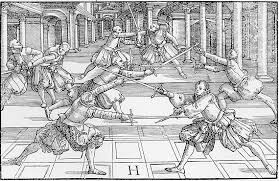
Note that to disorder the swords from out of measure (but not too far), for the first ripigliata you should bring your rear foot forward at the same time, then advance your front foot as the cut comes down.
After this, being in measure, you do not need to advance your rear foot, but to use your arm, without moving your feet, to effect the said displacements and cuts.
Alternatively, during the ripigliata, you can withdraw a little just your front (right) foot, then advance it to its original location as the cut comes down.
Take care not to stay in too wide a stance, to better sustain the great effort, and make use of your body, such that your enemies can easily be deceived by the measure, and you have greater space in which to extend your right foot, more or less as required. Staying very planted, taut like a crossbow in posture, is tiring. This is more necessary in the grand play of the thrust, where this unity is more useful for the actions that require it, especially the straight thrust.
Returning to combat against two opponents, in this (more than against three) the ventaglio is required. This consists in staying narrow in guard, with your body somewhat back, squatting or crouched, with your right knee somewhat curved and your left knee bent. Your sword-arm should be extended fully forward, with your left arm extended back if without a dagger. However if you have a dagger it should be forward, not depriving yourself of the dagger’s defence, although in being forward it should not pull the left side of your body too far forward, as this need to void as much as possible the aggression of your enemies’ blows.
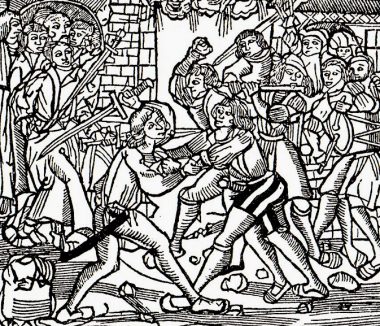
Your sword-hand should stay fairly low, to not be hit from underneath, with your point rather high, to defend all of your upper body.
In this manner, without disordering the opponents’ swords with a circuit of cuts as previously explained, you should parry their thrusts from the position of your hand, arm and sword described above.
Bringing your sword to the edge of the span of their swords, you should move through towards the other side, in the said posture, fanning with indescribable speed, and vigour of the arm, that is parrying to the outside and returning quickly to the ventaglio; and similarly if parrying to the inside.
Have no doubt that in this manner, given the fervour of the assault, and since the attackers are ardent and eager, they will oblige by confusing themselves and getting in each other’s way. Indeed in the ventaglio, it often happens that a sword which is parried and deflected goes on to displace the sword next to it. But since I cannot think how to describe this subject better, I wish to turn to other matters.
… I deem it proper to end our discussion of the sword with the sbaratto tondo, which signifies guarding yourself against multiple opponents if they attack from all sides. Round and around in a circle, the valiant fencer of the sbaratto, with skill and indescribable valour must adapt himself to combat while turning his body, and his sword, to all the areas where he could be attacked. He must employ cuts to defend against the enemies’ swords and to attack, but also no less thrusts in tempo. This should follow the general rule of the four thrusts, which I will explain as well as I can, using the circle below.
From this diagram, you must imagine that the point in the middle of the circle is your left foot, which is perpendicular. Like the wheel of a spur, your toes should point towards the appropriate letter, while the right foot is indicated only in one half-circle. From here, with a narrow stance, you should extend your right arm as far as you can from the right side of your body, to have greater reach in disordering your opponents’ swords.
In this manner, beginning the great sweep of the cut, you should lift your right foot, and place it along line A. When the cut has finished its course your hand should arrive at your left flank, such that as far as possible it reaches behind your left flank, so that it defends not only your front but also your back.
Having finished the cut, you should deliver a thrust along the said line A, advancing your right foot somewhat. However take care not to raise your left foot. In this action, without lifting from its spot, it should merely turn so it remains perpendicular to the said line. Once the arc of the cut is complete, and having delivered the thrust, from this position you should immediately begin the sweep of a new ripigliata.
As before lift your right foot, and turn your body to place it on line C. In the same moment your cut finishes its course, as far as it can reach to your right side, in this second phase of this same action (in which you move your right foot) you should lift your left foot to place it perpendicular to the said line C. Then having concluded the ripigliata with the cut, you should deliver a thrust, likewise along line C.
Note that in this second action, your right foot moves differently from in the first. In this action your right foot is only slightly raised while turning it, skimming the ground as described for your left foot in the first action. But be aware that to deliver the thrust in any direction, you must extend your right foot somewhat, to gain measure.
Having therefore finished with everything at line C, you should not waste time before turning with a ripigliata, with a movement of the feet, as executed before at point A. You should place your right foot along line B, allowing the cut to fall, as in the first case with your hand towards your left flank. Then having executed the thrust along line B, I advise you, with the usual daring speed, to reprise the arc of the cut as performed on line C.

Then, having completed the entire circle in the manner described, towards the four points indicated by the four lines and four letters, you should continue to perform the same actions; from where you find yourself, adjusting based on your judgement as urgency dictates.
In this sbaratto tondo, if you do not have time to extend the thrust, you can still practice the same rule of the four points with just the ripigliate, in the form of the long, wide cuts described. This is a simpler, although less offensive form of the sbaratto. However be aware that in this play you will not always have the occasion to strike your enemies’ weapons, either because they have not attacked with them, or because your opponents cunningly keep them withdrawn.
Likewise, by performing these ripigliate, to keep your opponents at bay, it is inevitable that one of them in putting his sword forward, or extending a thrust, will receive a stramazzone on his weapon, or at least a cut to his arm. If however the enemies stay far enough out of measure, without giving signs of approaching, the effect is the same as if they had no wish to attack. In such cases I advise the fencer of the sbaratto not to tire himself for no reason, but to stay alert, fixing his eyes around him, moving with small motions of his body, turning around to where he might most easily be deceived.
The flag can be employed in exactly the same play of the sbaratto, to the four points both with the ripigliate, and with the straight attack, with its sharp iron butt.

It occurs to say, that if after some time of the sbaratto, your enemies are overwhelmed or shaken, and take their distance, the brave spadone fencer may well rest in a proud and threatening pose. This is achieved by keeping your footing, turning your body as far as you can to the left, without moving your feet, while turning your face to the right, with your eyes fully alert turning sometimes to face the left.
At the same time, still with both hands, you should hold the spadone high towards your left shoulder, with the spadone’s point somewhat inclined towards your left side, as if in the act of wishing to strike with a riverso.
With which, not wanting to be too verbose, I take my leave of the ever diligent reader.
Footnotes
1 See for example: Huber, Michael. Seul contre tous: le combat à plus de duex adversaires, une lacune des livres de combat? In Cognot, Fabrice. Arts de combat: théorie & pratique en Europe – XIVe – XXe siècle (Paris, 2011) p.103-116.
2 Hundt, Michael. Ein new Kůnstliches Fechtbuch im Rappier (Leipzig , 1611) p.79, 94 & 98.
3 Germanisches Nationalmuseum, MS 3227a. sig.44v-45v.
4 Silver, George. Paradoxes of Defence (London, 1599) sig.A5v.
5 See for example Perinat, Juan Nicolás. Arte de esgrimir florete y sable por los principios más seguros, fáciles e inteligibles (Cadiz, 1758) p.37. This Spanish text suggests a method with the sabre against multiple opponents very similar to Giganti’s advice with the rapier.
Sir William Hope’s advice against multiple attackers does not directly correspond with any Italian rapier treatises, but does share some conceptual commonalities, it could be argued particularly with Colombani’s suggestions. See Hope, Sir William. A New, Short, and Easy Method of Fencing: or, the Art of the Broad and Small-sword Rectified and Compendiz’d, etc (Edinburgh,1707) p.176-8.
6 For example compare the sbaratto tondo with Pablo de Paredes’ rule for combat against multiple opponents in a wide street in 1599, reproduced in: Lhermite, Jehan. Le Passetemps de Jehan L’hermite publié d’après le manuscrit original par Ch. Ruelens: Volume 2 (Antwerp, 1896) p.242.
This should not necessarily be surprising. Alfieri wrote his rapier treatise in 1640 before writing his spadone treatise in 1653. See Alfieri, Francesco Ferdinando. La scherma (Padua, 1640); and Alfieri, Francesco Ferdinando. Lo Spadone (Padua, 1653).
Whereas Gaiani states: “I highly recommend that at least twice a week masters give lessons in the spadone to diligent students, because this is the best way to make your body good and ready for every movement, as well as strengthening your wrist.” See Gaiani, Giovanni Battista. Arte di maneggiar la spada a piediet a cavallo (Loano, 1619) p.43.
7 See for example chapter 10 of Alfieri’s Spadone, translated in: Mondschein, Ken. The Art of the Two-Handed Sword (New York: SKA Sword Play Books, 2012) p.42-3.
8 D’Alessandro, Giuseppe. Opera: divisa in cinque libri ne’ quail si tratta delle regole di Cavalcare etc. (Naples, 1723). p.478-482.
9 Bibliothèque Nationale de France, MS Italien 959. Lovino, Giovanni Antonio. Ragionamento sopra la scienza dell’arme (circa 1580) sig.57r-57v.
10 Literally “inside guard”, also referred to as guardia di meza coperta (“half-cover guard”). The point is forward, with the hand extended, with the palm turned upwards, similar to a rapier quarta.
11 Fabris, Salvator. De lo schermo overo scienza d’arme di Salvator Fabris Capo dell’ordine dei sette cori (Copenhagen, 1606) p.8-9.
12 Terminiello, Piermarco, and Pendragon, Joshua. The ‘Lost’ Second Book of Nicoletto Giganti (1608): A Rapier Fencing Treatise (London, 2013) p.47-9.
http://www.amazon.com/Lost-Second-Book-Nicoletto-Giganti/dp/1909348317
13 Colombani, Giuseppe. L’arte maestra (Venice, 1711) p.7.
14 Calarone, Costantino. Scienza pratica necessaraia all’huomo; overo modo per superare la forza coll’uso regolato della spada (Rome, 1714) p.342.
15 A Latin proverb: “Not even Hercules [could prevail] against two”.
16 Calarone’s pianta perfetta is a fairly typical Italian rapier posture, somewhat backweighted, with the back (left) knee bent and the front leg extended.
17 The passo misto (literally the “mixed step”) is not explicitly defined by Calarone, but other authors describe it as an action whereby the rear (left) foot wheels around to the right; either as part of an inquartata, or following the lunge, instead of recovering backwards in a straight line.
When utilising this sort of footwork, Calarone advocates a narrower stance than with his pianta perfetta: three and a quarter feet wide instead of four. See Calarone (1714) p.69.
For usage by other authors see Pallavicini, Giuseppe Morsicato. La scherma illustrata (Palermo, 1670) p.26; and Marcelli, Francesco Antonio. Regole della scherma insegnate da Lelio e Titta Marcelli etc. (Rome, 1686) p.106.
Perhaps of significance is that Pallavicini refers specifically to Docciolini in describing this action. Docciolini advocates a moderate lunge, and habitually recovers to one or other side, but at a narrower angle than typical for an inquartata. See Docciolini, Marco. Trattato in materia di scherma (Florence, 1601).
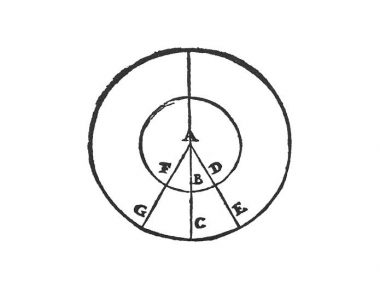
Docciolini’s 1601 footwork diagram, provided for comparison. The right foot starts at B with the left perpendicular at C, a third of the fencer’s height apart. During the lunge the right foot advances to A. In order to recover to the right-hand side,the left foot must then quickly wheel round to E, with the right then recovering to D.
18 Calarone defines perfect measure (misura perfetta) as when the strong (forte) of your sword touches the beginning the opponent’s weak (debole). See Calarone (1714) p.75.
21 D’Alessandro describes this action the verb ripigliare and the noun ripigliata (plural: ripigliate). I hae left the noun ripigliata untranslated, but to avoid awkward constructions have translated ripigliare as disorder.
Note that ripigliare has a different meaning in modern Italian fencing terminology (namely a remise), but in D’Alessandro’s nomenclature it has a different meaning: a bold, sweeping cut/beat. However in both senses the implication is a repeated action. Indeed Florio’s English/Italian bilingual dictionary of 1611 gives one definition of ripigliare as “to bandie to and fro”. See Florio, John. Queen Anna’s New World of Words (London, 1611) p.442-3.
22 Note that this contrasts with Calarone’s advice above.
23 This can be translated as the “round fury”.
24 Again contradicting Calarone’s advice.
25 As earlier noted, literally “the fan”.
26 D’Alessandro is very clear on this point, although it is rare elsewhere for European systems of fighting with two-handed swords to advocate leading with the left hand, although Alfieri depicts one image with a left-hand lead (reproduced twice in the treatise). See Mondschein (2012) p.47 & 59.
However left-hand leads are common for example in the staff-fighting of Jogo do Pao, and but with polearms. This tendency is evidenced by the fact masters who teach an orthodox right-hand lead for the spadone, typically teach a left-hand lead for the halberd. For examples see: Di Grassi, Giacomo, Ragione di adoprar sicuramente l’arme si da offesa come da difesa (Venice, 1570); and Palladini, Camillo. Discorso di Camillo Palladini Bolognese sopra l’arte della scherma. Come l’arte della scherma è necessaria à chi si diletta d’arme (late sixteenth century, Wallace Collection, De Walden Library 14/10).
Acknowledgments
Thanks to James Clark for providing many valuable insights into the related spadone, montante and longsword material, and to Fran Terminiello for reviewing an earlier draft of this article.
Unless otherwise noted all translations are the author’s. All rights reserved.

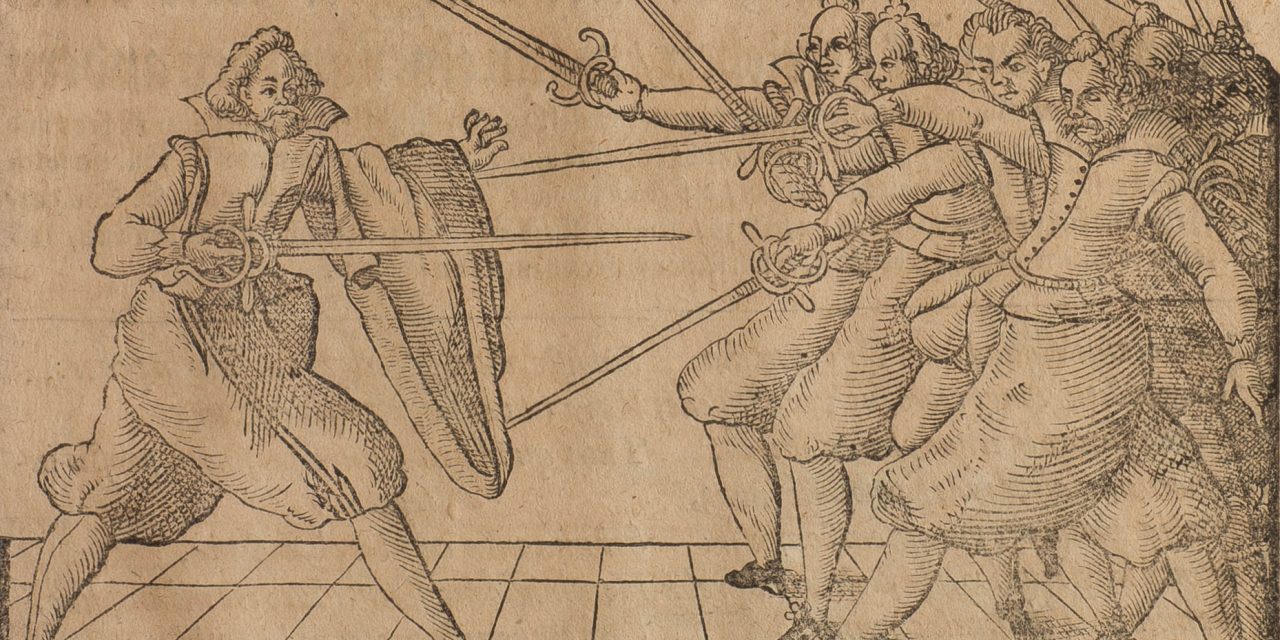

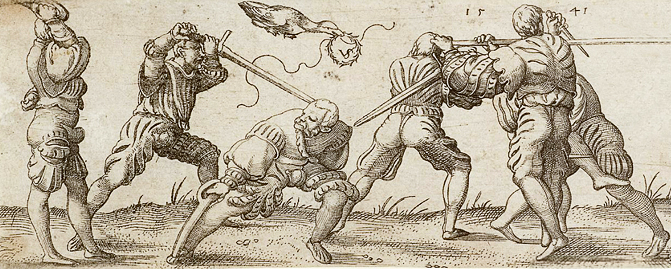
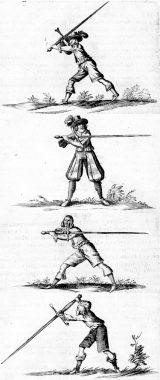
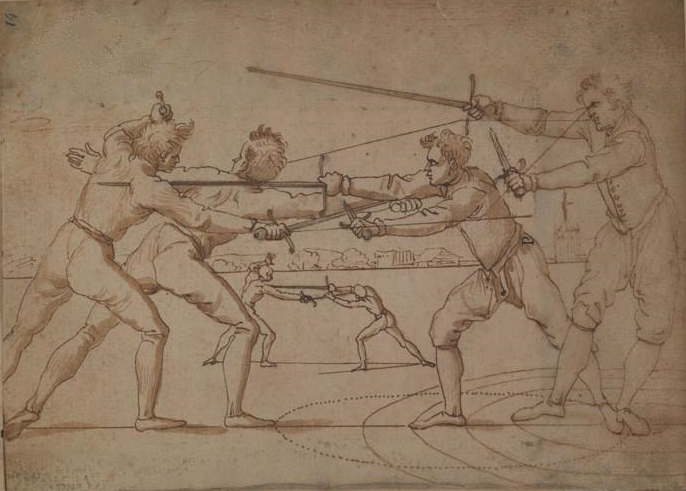
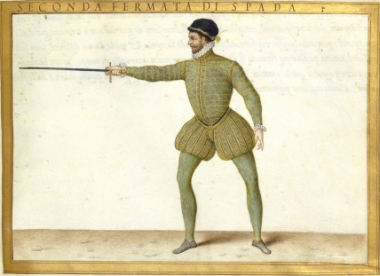
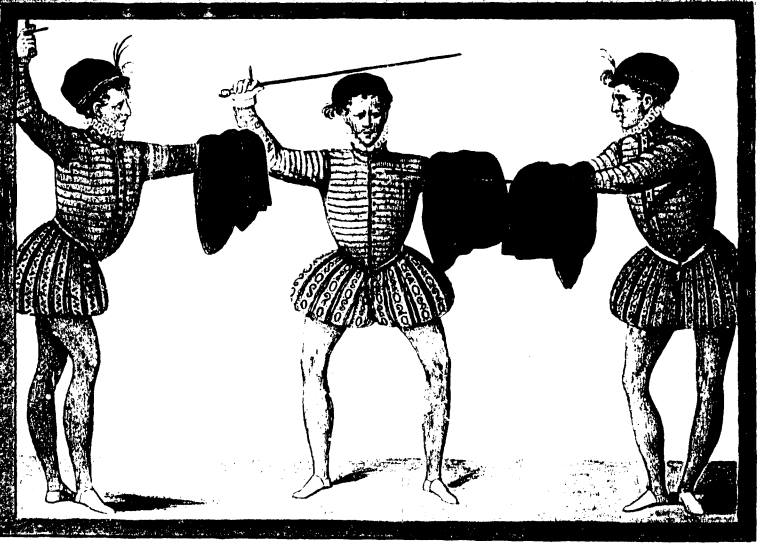

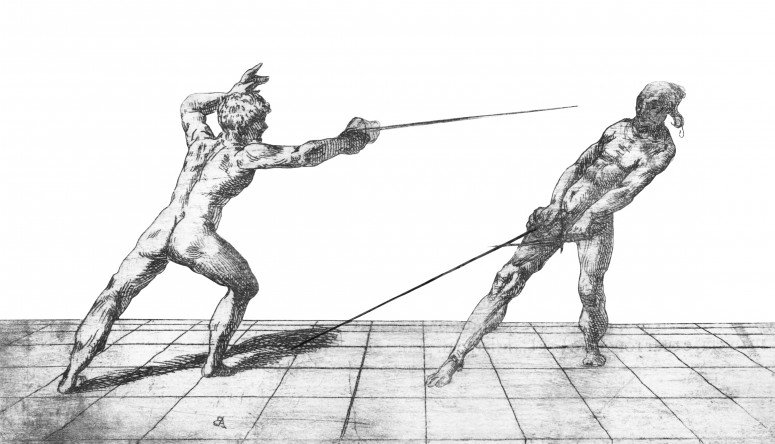
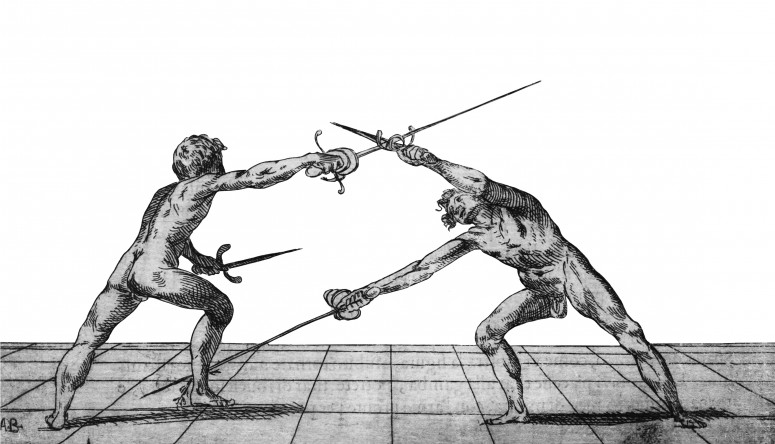

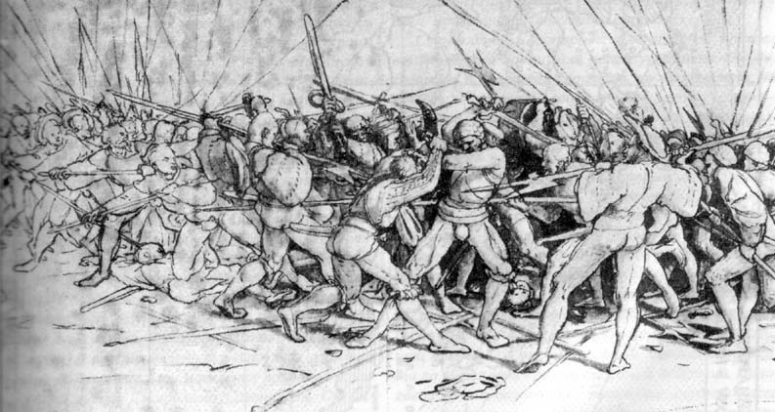

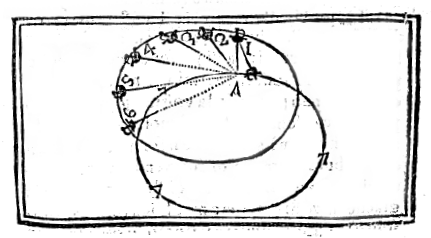





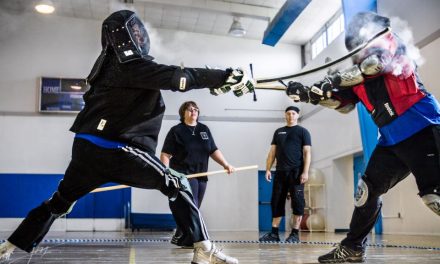

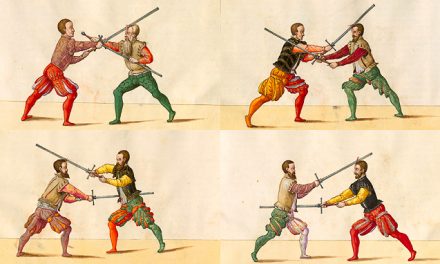




Brilliant article Pim. I think this changes the way we look at the history of fencing a bit – rather than a progression of cut to thrust, cut and thrust in different pedagogical, social, and situational contexts. Looking forward to your next piece!